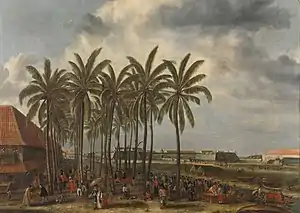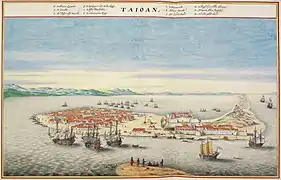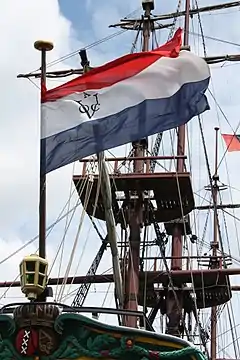Transnational corporation
A transnational corporation is an enterprise that is involved with the international production of goods or services, foreign investments, or income and asset management in more than one country. It sets up manufacturing factories in developing countries as land is cheaper there.
Characteristics
.jpg.webp)



Transnational corporations share many qualities with multinational corporations, with the subtle difference being that multinational corporations consist of a centralized management structure, whereas transnational corporations generally are decentralized, with many bases in various countries where the corporation operates.[9] While traditional multinational corporations are national companies with foreign subsidiaries,[10] transnational corporations spread out their operations in many countries to sustain high levels of local responsiveness.[11]
A transnational corporation operates substantial facilities, does business in more than one country, and does not consider any particular country its corporate home. One of the significant advantages of a transnational company is that they are able to maintain a greater degree of responsiveness to the local markets where they maintain facilities.[12]
Transnationality also refers to the extent to which a firm engages in value-creating activities across national borders. Faced with accelerated globalization, managers often make decisions to expand a firm's transnationality in order to enable the firm to effectively compete with rivals on a global scale (e.g. Nestlé, Deutsche Post, Toyota, etc.), who employ senior executives from many countries and tries to make decisions from a global perspective rather than from one centralized headquarters.[13][14] Actions taken with transnational cooperation can help create better relationships between nations. Resources that are found in nations often need to be spread out throughout the world and thus transnationality helps this process.
The history of transnational corporations dates back to Western Europe in the 16th century. During this time firms like the British East India Company were founded.[15]
See also
References
- Brenner, Reuven (1994). Labyrinths of Prosperity: Economic Follies, Democratic Remedies. (University of Michigan Press, 1994), p. 57-60
- Moore, Jason W. (2010b). "'Amsterdam is Standing on Norway' Part II: The Global North Atlantic in the Ecological Revolution of the Long Seventeenth Century," Journal of Agrarian Change, 10, 2, p. 188–227
- Chen, Piera; Gardner, Dinah: Lonely Planet: Taiwan [10th edition]. (Lonely Planet, 2017, ISBN 978-1786574398).
- Shih, Chih-Ming; Yen, Szu-Yin (2009). The Transformation of the Sugar Industry and Land Use Policy in Taiwan, in Journal of Asian Architecture and Building Engineering [8:1], pp. 41–48
- Tseng, Hua-pi (2016). Sugar Cane and the Environment under Dutch Rule in Seventeenth Century Taiwan, in Environmental History in the Making, pp. 189–200
- Estreicher, Stefan K. (2014), 'A Brief History of Wine in South Africa,'. European Review 22(3): pp. 504–537. doi:10.1017/S1062798714000301
- Fourie, Johan; von Fintel, Dieter (2014), 'Settler Skills and Colonial Development: The Huguenot Wine-Makers in Eighteenth-Century Dutch South Africa,'. The Economic History Review 67(4): 932–963. doi:10.1111/1468-0289.12033
- Thompson, Laurence G. (1964), 'The Earliest Chinese Eyewitness Accounts of the Formosan Aborigines,'. Monumenta Serica 23(1): 163–204. Laurence G. Thompson (1964) noted, "The most striking fact about the historical knowledge of Formosa is the lack of it in Chinese records. It is truly astonishing that this very large island, so close to the mainland that on exceptionally clear days it may be made out from certain places on the Fukien coast with the unaided eye, should have remained virtually beyond the ken of Chinese writers down until late Ming times (seventeenth century)."
- Biersteker, Thomas (1978). "Distortion of Development? Contending Perspectives on the Multinational Corporation". Cite journal requires
|journal=(help) - Drucker, Peter F. (1997). "The Global Economy and the Nation-State". Foreign Affairs. 76 (5): 159–171. doi:10.2307/20048206. JSTOR 20048206.
- Case study: The Relationship between the Structure/Strategy of Multinational Corporations and Patterns of Knowledge Sharing within them (PDF). Oxford University Press. 2009.
- "What is transnational company? definition and meaning". BusinessDictionary.com. Retrieved 2020-10-09.
- Schermerhorn, John R. (2009). Exploring Management. John Wiley and Sons. p. 387. ISBN 978-0-470-16964-3.
- "Integrated international production". World Investment Report 1993. United Nations Conference on Trade and Development (UNCTAD) World Investment Report (WIR). 1993. doi:10.18356/e39588ec-en. ISBN 9789213626696. ISSN 2225-1677.
- "How the East India Company became the world's most powerful business". https://www.nationalgeographic.co.uk/history-and-civilisation/how-east-india-company-became-worlds-most-powerful-businessNational Geographic. Retrieved 2020-10-23.
